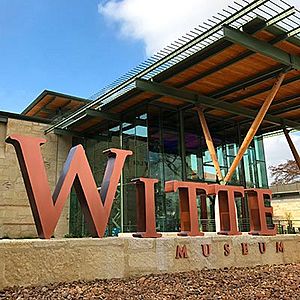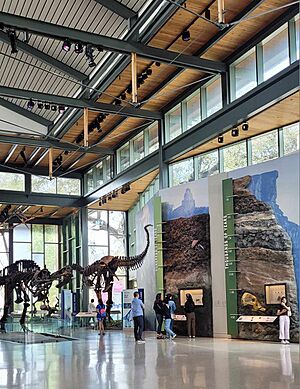Witte Museum facts for kids
 |
|

Witte Museum in San Antonio, Texas
|
|
| Lua error in Module:Location_map at line 420: attempt to index field 'wikibase' (a nil value). | |
| Established | 1926 |
|---|---|
| Location | 3801 Broadway, San Antonio, Texas, |
| Type | Nature History Science |
| Visitors | 500,000 |
| Public transit access | |
The Witte Museum is a cool place in San Antonio, Texas. It opened way back in 1926. This museum is all about sharing the amazing stories of Texas. It covers everything from ancient times to today.
You can see lots of interesting things here. There are old artifacts, photos, and art from Texas. They also have textiles, real dinosaur bones, and even cave drawings! You can also explore displays of Texas wildlife. Plus, the museum often hosts special exhibits that travel from other places.
The museum is named after Alfred G. Witte, a businessman from San Antonio. He left money to the city to build a museum. He wanted it to be a place for art, science, and natural history. The first director of the Witte Museum was Ellen Schulz Quillin.
Contents
History of the Witte Museum
How the Museum Started
The idea for the Witte Museum began with a huge collection of natural history items. These belonged to Henry Philemon Attwater. Ellen Schulz Quillin, a teacher and plant expert, bought this collection for San Antonio. It cost $5,000.
The collection grew so big it didn't fit in the high school anymore. So, Ellen Schulz and her friends asked the city for money. They wanted to build a new museum. With that money and a gift of $65,000 from Alfred G. Witte, the new building was constructed.
The museum was first called the Witte Memorial Museum. This name lasted until 1984. Then, it was simply changed to the Witte Museum.
Art at the Museum
Besides natural and historical items, the Witte also had paintings, sculptures, and drawings. In 1970, the museum director, Jack McGregor, suggested creating a separate art museum.
In 1972, with help from museum leaders, the San Antonio Museum Association bought an old brewery. This building was renovated to become an art museum. The San Antonio Museum of Art opened on March 1, 1981. The Witte Museum's art collection now focuses on art made by artists living in Texas. It also shows art that represents Texas history and culture.
Exciting Museum Changes and New Additions
Early Additions: 1930s-1970s
- 1930s: The Witte Museum helped with important research. They studied ancient sites in the Big Bend and Lower Pecos areas. This led to many new artifacts and new galleries to show them. A "Reptile Garden" was also built. It was a vision of the founder, Ellen Schulz Quillin. This garden helped the museum earn money. It also helped local ranchers who sold snakes to the museum. Two old log cabins were also built. Young people in a special program helped build them. These cabins teach students about pioneer life.
- 1940s: Two historic San Antonio houses were moved to the museum grounds. One was the stone home of John Twohig, an early San Antonio merchant. The other was the plastered stone home of José Francisco Ruiz. He was the city's first schoolmaster. He also signed the Texas Declaration of Independence.
- 1960s: New historical exhibits and better art galleries were added. These included the McFarlin Jewel Room. The Piper Memorial Wing was also added for temporary exhibits.
- 1970s: The "Lone Star Hall of Wildlife and Ecology" opened in March 1971. It featured amazing displays of Texas wildlife. This was thanks to the hard work of William A. Burns, a museum director.
Modern Expansions: 1980s-2000s
- 1980s: Several big new exhibits were added. These included "Texas Wild" and "Ancient Texans."
- 1990s: The "H-E-B Science Treehouse" opened. It overlooked the San Antonio River. This area offered fun, hands-on science exhibits. Many students visited the Witte to explore it.
- 2000s: In 2003, the Hertzberg Circus Collection moved to the Witte Museum. This collection is one of the oldest and largest public circus collections. It includes artifacts, programs, photos, and more. Marise McDermott became the President and CEO in 2004. She has led many expansion projects since then:
- The "H-E-B Science Treehouse" became the "H-E-B Body Adventure." This was the first interactive health experience for kids in the U.S.
- The "B. Naylor Morton Research and Collections Center" opened. It displays over 300,000 artifacts. It also provides space for experts and students to study the growing collection.
- The "Mays Family Center" opened. It's a large space for exhibitions and special events.
Recent Major Renovations: 2010s
- 2012: The "Robert J. and Helen C. Kleberg South Texas Heritage Center" opened. This is a permanent home for the museum's South Texas collections. It uses the latest museum technology. The collections show the area's history. They include saddles, spurs, baskets, and old clothing.
- 2014: The museum started a huge $100 million renovation project. This updated over 174,000 square feet of space. New areas included the "Naylor Family Dinosaur Gallery and Dinosaur Lab." There was also the "Valero Great Hall," the "McLean Family Texas Wild Gallery," and the "Kittie West Nelson Ferguson People of the Pecos Gallery." A new parking garage was also built.
The design team, led by Patrick Gallagher, created new exhibit graphics and videos. They updated the wildlife displays and added touch screens. They also included interactive displays and sound effects. This project aimed to be environmentally friendly. It achieved a special certification for its sustainable designs.
Valero Energy gave $4 million to help with the expansion. This money funded the "Valero Great Hall." This hall has glass walls and is the main entry area. Inside, you can see amazing replicas of dinosaurs. These include an Acrocanthosaurus atokensis, a Tyrannosaurus rex, and a Quetzalcoatlus flying overhead. The Quetzalcoatlus has a huge forty-foot wingspan!
The grand opening of "The New Witte" happened on March 4, 2017. Many important people attended. In the month after opening, over 90,000 visitors came to see the new museum.


